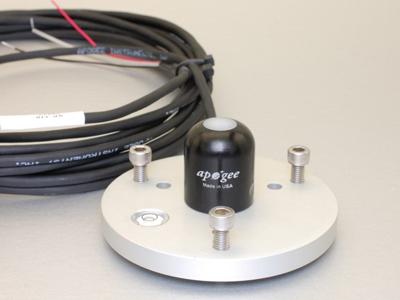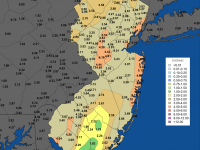Introduction
Serving a wealth of potential user needs, solar radiation is one of the many variables observed at stations within the Rutgers NJ Weather Network (NJWxNet). Dating back as far as 2004, the original solar network of a half dozen stations has grown to the current 46. The solar instruments record incoming radiative fluxes in the 0.36 to 1.12 micron range. A myriad of products stem from observations, initially gathered once each hour and, since mid-2012, every five minutes. These include radiation maximums, averages, minimums (W/m²), and totals (kJ/m²), at five minute, hourly, and daily time scales.
Solar data gathered at NJWxNet sites help promote an understanding of the relationship between solar radiation and terrestrial systems involving the heating of the surface and atmosphere, plant growth, human health, and energy generation. Atmospheric conditions influence the magnitude of irradiance reaching the surface, with variables such as cloud cover, humidity, and aerosols (minute natural and human-generated liquid or solid particles) influencing incoming radiation. Prior to the advent of the NJWxNet, solar radiation observations across the Garden State were few in number and most often not of a continuous long-term nature. This was the case elsewhere in the US prior to the recent establishment of mesonets, such as the NJWxNet, in many states.
Here, we explore the solar data being gathered at NJWxNet stations and demonstrate the potential value of these observations to energy, meteorological, engineering, and other communities. According to “Shining On,” a publication on the National Solar Radiation Database, harnessing and utilizing just 0.2% of the solar energy incident on the US landscape would meet the energy demand for the nation as a whole. In a world fueled by limited power sources such as oil, coal, and natural gas, solar radiance is a perpetual source of energy having tremendous potential. Understanding NJ’s solar climatology on multiple scales can help us determine how effective solar panels will be, and how the incoming solar radiation affects meteorological conditions.
Observations and Methods
Of the many stations supporting solar measurements in the NJWxNet, Pittstown was used for this analysis. One of the original NJWxNet stations to measure solar radiation, the station is located in an open field at Rutgers University’s Snyder Farm in Hunterdon County. There is little to no obstruction of direct sunlight due to nearby trees or structures at any time of the day or in any direction circling the station. Solar irradiance is measured using an Apogee SP-110 pyranometer, which measures sun (direct) plus sky (diffuse) radiation. For this analysis, we will focus on daily maximums, minimums, totals, and averages. The behavior of these variables, along with relationships between heliacal and meteorological variables, are demonstrated in the following charts.

Results
The graphs below illustrate how solar radiation varies by season and over a range days with differing atmospheric conditions. Each graph is accompanied with bulleted comments that describe what is being shown and, in some cases, speculate as to why these conditions are observed.
Total daily accumulated solar radiation at two levels in 2018:
• Two levels are plotted: top of atmosphere (TOA; calculated) and the surface (called insolation; measured) at Pittstown. TOA solar radiation represents the amount of solar energy impinging on an imaginary surface parallel to the earth’s surface at the top of the upper atmosphere before any effects from the atmosphere occur.
• The parabolic shape of the TOA solar radiation has a maximum at the summer solstice, and minimum at the winter solstice.
• It is apparent that only a fraction of the TOA solar radiation reaches the surface.
• The irregular and jagged variations of the surface insolation are primarily determined by fractional cloud cover, although factors such as atmospheric precipitable water and particulate matter also influence radiation at the surface.
• Note that in general even on a cloudy summer day, more insolation is measured at the earth’s surface than on a clear winter day.

Five-day average percentages of solar radiation reaching the surface over a four year period at Pittstown.:
• On average, 47.9% of the incoming solar radiation (solid red line) reaches the surface. The other half is absorbed within the atmosphere or reflected back out into space (mainly by clouds) before reaching the surface.
• Lower values tend to occur most often in winter and higher values in summer. This suggests that winter cloud cover is more frequent than in summer. Also, with a lower solar elevation angle* in the winter, there is a longer pathway through the atmosphere for solar radiation before making it to the surface, thus greater potential for absorption and reflection of solar radiation within the atmosphere compared to summer. However, this may be counterbalanced by a drier and less hazy atmosphere in winter compared to summer .
*The solar elevation angle is measured from the horizon to the center point of the sun. The angle from directly above a location to the center point of the sun is known as the solar zenith angle.

Seasonal average percentages of solar radiation that reached the surface at Pittstown, 2015–present:
• The plot highlights the seasonal differences in amount of TOA solar radiation reaching the surface.
• Winter tends to have a lower percentage and summer the highest (as visible in figure above).
• There was a significant decline in the percentage of solar radiation reaching the surface during fall 2018 compared to other falls and even the lowest winter value. The plot below shows excessive cloud cover in Fall 2018 at Newark Airport (KEWR) compared to the prior three years, likely explaining this notable minimum percentage *.
*Days with “significant cloud cover” were estimated using hourly cloud cover conditions at KEWR, with a point value of 0 designated for clear or scattered, 0.5 for broken, and 1 for overcast. These points were then summed for each day. If the daily total was greater than 18, it was determined to be a significantly cloudy day.


5 minute solar radiation on a sunny day at Pittstown, August 29, 2019:
• Radiation reaching the surface on a mostly clear day at Pittstown, with a few passing cumulus clouds during the middle of the day and in the late afternoon.
• The smooth five-minute surface solar radiation line is apparent in the morning and evening hours, as there are no clouds or variations in atmospheric turbidity present to cause deviations from a smooth daily cycle that is quite similar in shape to solar radiation at the top of the atmosphere. The shape is not identical, as the lower solar elevation angle early and late in the day (longer solar pathway through the atmosphere) result in a reduced percentage of radiation reaching the surface compared to around midday.
• The early morning insolation reaching the ground is a slightly lower percentage of TOA radiation than late in the day. This may be the result of a slightly more open landscape (thus sky view) to the west of the station than toward the eastern horizon.
• At one point early in the afternoon the percent incoming radiation jumps above the overall shape of the curve, with much lower values immediately before and after (see arrow). These values are all associated with patchy cloud cover, with the higher value illustrating the “silver lining” of clouds when radiation is reflected off the sides of clouds from multiple directions and reaches the sensor. This doesn’t last long, as the moving clouds will also frequently shade the station.

5 minute solar radiation on a partly cloudy day at Pittstown, August 25, 2019:
• Radiation reaching the surface on a partly cloudy day at Pittstown. Cumulus clouds were present for a good portion of the daylight hours, causing more frequent large variations in surface radiation.
• There are some instances where the surface radiation comes close to TOA radiation. This is again the result of the “silver lining” effect.
• The jagged nature of this surface radiation time series resembles the total daily surface radiation graph (the first graph shown above), with peaks and troughs due to varying cloud conditions over daily or multiple day intervals.

5 minute solar radiation on a cloudy day at Pittstown, October 3, 2019:
• A heavily cloud-covered day in Pittstown with incoming solar radiation remaining below 200 W/m² throughout the day. A partly cloudy or sunny day may see values at this time of year reach 900 W/m².
• The majority of the radiation entering the atmosphere above the station is being reflected back into space off the top of the clouds, while some is being absorbed within the clouds or even by aerosols throughout the atmosphere.







